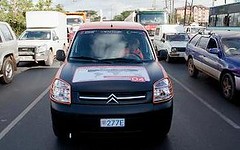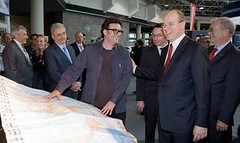一輛電動車首次嘗試在沒有外力協助之下,由肯亞奈洛比行駛至南非的約翰尼斯堡,預計航程長達4800公里。聯合國環境規劃署(UNEP)在10日的記者會上發表這項壯舉,這輛亮橘色的電動車11日近乎無聲地駛離UNEP奈洛比總部,UNEP早期預警暨評估計畫主任 Peter Gilruth在出發點揮舞著旗幟,與駕駛人Xavier Chevrin餞別。

Chevrin是法屬留尼旺島的一名英文教師,具有長途駕駛電動車的經驗。他於2010年以電動車創下上海到巴黎間行駛的紀錄,距離長達13400公里。
這項稱為「非洲任務」(Mission Africa) 的旅程,是聯合國「所有人能享用永續能源年」(Year of Sustainable Energy for All)推廣計畫的一部分,目的在展現電動車在極端環境下的能量效率,並凸顯非洲仍有許多人面臨缺電的問題。
根據 UNEP 即將發表的環境況況旗艦報告《全球環境展望 5》指出,目前的運輸部門使用的石化燃料排放,佔了所有溫室氣體的1/4,而且這個數字將在未來十年間提高到1/3。
 Chevrin表示,電動車是零排放的,而且比駕駛燃油車更省。
Chevrin表示,電動車是零排放的,而且比駕駛燃油車更省。
電動車從上海開到巴黎只花不到200美金,相較之下,柴油車的花費將達4000美金。
Chevrin 說,「要成功完成旅程除了得仰賴機械的超高效能之外,還需要過程中遇到的人的幫助。若沒有後援或事先計畫好停車點的情況下,你需要倚靠偶然遇到的機會,在每個點之間每天期望有所進展。」
 然而,他將面臨著非洲農村有限且不穩定的電力供應問題。這輛車沒有備用的發電機,若電力耗盡他將動彈不得,更添這趟冒險的難度。
然而,他將面臨著非洲農村有限且不穩定的電力供應問題。這輛車沒有備用的發電機,若電力耗盡他將動彈不得,更添這趟冒險的難度。
這輛電動車是雪鐵龍Berlingo電動版,由文圖瑞(Ventur)提供電動動力系統,由法國郵政局所使用車型升級而來。
法國郵政局所使用的車型配有一個鈉鎳氯化物電池,而 Chevrin所駕駛的車型則有三個。在標準240伏特的條件下,充滿電池需要7個小時。
 雪鐵龍 Berlingo 有加長型懸吊系統,可以應付顛簸的路面。充滿電時可在每小時110公里的極速下行駛500公里。
雪鐵龍 Berlingo 有加長型懸吊系統,可以應付顛簸的路面。充滿電時可在每小時110公里的極速下行駛500公里。
「非洲任務」計畫由摩納哥王子阿爾貝二世基金會所資助。這個基金會的首要目標是開發中國家,並關注下面三個主要環境議題:對抗氣候變遷、生物多樣性保育以及水資源的永續管理。
For the first time, an electric vehicle is attempting an unassisted journey from Nairobi to Johannesburg, South Africa - a distance of 4,800 kilometers (2,982 miles).
The driver is Xavier Chevrin, who left today after a sendoff news conference Thursday at the Nairobi headquarters of the United Nations Environment Programme.
Peter Gilruth, director of UNEP's Division of Early Warning and Assessment, flagged off the bright orange vehicle, which drove off with barely a hum from its silent electric motor.
Chevrin is an English teacher on the French Ile de la Réunion with a history of long trips in electric cars. His 2010 trip from Shanghai to Paris was the longest journey ever made in an electric vehicle - a distance of 13,400 km (8,326 miles).
Called Mission Africa, the journey is part of the UN International Year of Sustainable Energy for All, aims to demonstrate the reliability and energy efficiency of electric vehicles under extreme conditions and also highlight the lack of electricity in many communities in Africa.
According to UNEP's soon-to-released flagship report on the state of the environment, the Global Environment Outlook 5, the current fossil-fuel based transport system accounts for a quarter of all greenhouse gas emissions.
This figure is expected to rise to almost one third in the coming decades.
Chevrin pointed out that the electric vehicle puts out zero emissions and is much cheaper to run than petrol-fueled cars.
The Shangai-Paris trip cost less than US$200 dollars in electricity, compared to the $4,000 it would have cost to use diesel, Chevrin said.
"The successful completion of such a journey depends not only on incredible performances from a machine, but also the people you meet throughout the entire trip," Chevrin said. "Without any back-up or pre-planned stopovers, you have to rely on chance encounters, hoping to progress each day from one point to the next."
However, he will face the challenges of limited access to electricity and frequent power cuts in rural Africa. The car has no back-up generator, so should he run out of power he will be stranded, adding to the scale of the adventure.
The vehicle is a Citroen Berlingo powered by Venturi, an enhanced version of cars used by the French postal service.
While the vehicle in use by La Poste has one nickel sodium chloride battery, the vehicle Chevrin is driving down to Johannesburg has three. Recharging the batteries from scratch takes seven hours, plugged into a standard 240 volt socket.
The Citroen Berlingo features a raised suspension to cope with bumpy roads. It can cover 500 km (300 miles) without recharge at a maximum speed of 110 Km/h (68 mph).
Mission Africa is supported by the Prince Albert II of Monaco Foundation. The foundation has a priority interest in developing countries and is focused on three main environmental issues: the fight against climate change, biodiversity conservation and sustainable management of water resources.







